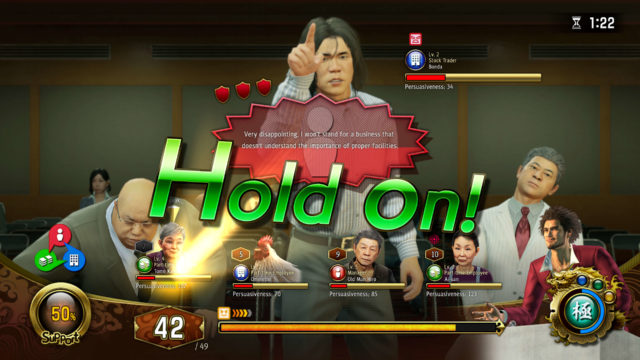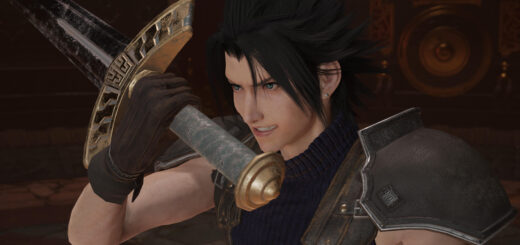Yakuza: Like a Dragon Impression
It’s often flat-out ridiculous, but also just as great.
After seven entries as the main protagonist in the Yakuza series, Kazuma Kiryu has finally handed the reins over. While he gets a much deserved rest, new character Ichiban Kasuga fills the role for Yakuza: Like a Dragon. Ahead of the game’s western launch next month, Sega gave RPGamer the opportunity to check out the game’s fifth chapter and bringing back some impressions of the game and its English localisation. The fifth chapter should come in at around the five-to-seven hour mark for most playthroughs, and is where the game starts to fully open up, letting players explore and partake in the familiar copious amounts of side content.
Major changes are immediately evident, and a new protagonist isn’t even the biggest shake-up, as Yakuza: Like A Dragon massively alters combat by bringing a turn-based battle system, complete with four-person party. There’s clear inspiration from Dragon Quest running throughout, with the obvious influences from both it and Persona in the combat system joined by lots of little and large references. Ichiban himself is a huge fan of the series, and gleefully plays into the opportunity to compare his situation to that of an RPG hero and that translates to how he and the player view everything.
The game is absolutely delighted to play into the series’ over-the-top violence and take it even further, using the opportunity to combine a traditional RPG job system with actual vocations. Characters can change into a wide variety of different jobs that might sound mundane — such as chef and hostess — but are impressively translated into the combat system for useful and powerful abilities. In addition to basic equipment upgrades, characters have two levels: a universal character level and a job level, with both providing attribute upgrades when upped through the standard experience system while levelling a job offers new abilities on top.
It’s appreciable how much effort has been put into the job system and all of the abilities. Each skill has its own dedicated, appropriately flashy animation. These get ramped up even further with special summons that Ichiban can acquire, including an army of crayfish, though these usually have a cash cost to use. There is good variation between the jobs as well, with some better at dealing physical or elemental damage (complete with enemies being weak to certain types) and others offering useful support abilities. The game in general looks really nice, with Ryu ga Gotoku Studio once again putting in a great amount of effort to bring its locations to life with loads of nice touches, big and small.
The only real issue with the system is that attempting to use area-of-effect attacks can be challenging, as enemies will keep moving around and spreading out away from the effect range, and there is no visual indicator of how large the range actually is. It’s a little bit off that while movement cannot be controlled it affects the combat in multiple ways; characters can end up intercepted and blocked by other enemies, while party members can use detritus in the arena, such as kicking a cone at the enemy while running to make the attack. However, these are ultimately minor concerns, as the combat’s quick flow works very nicely and ensures that most battles don’t actually feel any slower than the previous game’s action fights. It’s often flat-out ridiculous, but also just as great. The normal difficulty set for the build didn’t offer any great challenges, though the party may have been at a higher level and it was still a fairly early part of the game.
The fifth chapter takes place in the new district of Isezaki Ijincho in Yokohama (based on the real-life Isezakichō district). The main story in the chapter did have plenty of interesting elements, focusing on Ichiban and his recently-collected down-on-their-luck allies and their attempts to infiltrate a Chinese gang, while also introducing a nationalist group called Bleach Japan. Despite not seeing the steps that got them there, there’s already a great sense of camaraderie from Ichiban and his party as the group work together and help support each other through some tough times, while making sure to enjoy what they can. Ichiban is very much a different character to Kiryu, but with his energetic and upbeat attitude, he’s a cheerful protagonist who is easy to root for.

Yakuza: Like a Dragon keeps up the ridiculous amount of side content and mini-games that series fans expect.
Though some things are vastly different, Yakuza: Like a Dragon absolutely retains the overall feel of a Yakuza game. There’s a distinct divide between the often deadly serious main plot involving the criminal underworld and much of its side content that works well in giving players the opportunity to putter around as they wish. Ijincho has a very apparent financial divide, and some of these early sidequests do a great job examining the divide by focusing on some of the homeless denizens, particularly one involving a volunteer soup drive and another about a character trying to think up an appropriate birthday present. The side content acts as though Ichiban is on his own and the rest of the party briefly wanders off during any event scenes, but given the possibility of party members not being around at certain points, it’s completely understandable that it is done this way and the side content provides enough immersion to readily overlook this limitation.
There is also plenty that is more lighthearted or aimed to mix up the gameplay, such as Dragon Karting and a whole story-related campaign involving running a business, and Yakuza: Like a Dragon really looks to be covering all of the possible bases that one can do in a single game. The side content is nicely implemented into gameplay bonuses, as Ichiban has personality stats that will raise as players do more, which can unlock further jobs. There are opportunities to learn more about Ichiban’s allies at the Survive bar, and party members all have a bond level that rises through combat and missions, in turn providing even more event scenes and jobs.
The English localisation is in line with that of Judgment in that it retains the Japanese voicing on some of the more incidental elements like entering stores or restaurants. The English voice acting is as strong as one might expect from Sega and Atlus following its recent efforts, along with the localisation in general.
Yakuza: Like a Dragon looks to be an ideal melding of an opportunity for new players to get into the series, while adding a great sense of freshness for returning players. From what I’ve been able to play so far, Ryu ga Gotoku Studio skirts that fine line between being serious and ridiculous incredibly well. I absolutely look forward to checking the full game out next month.







Recent Comments